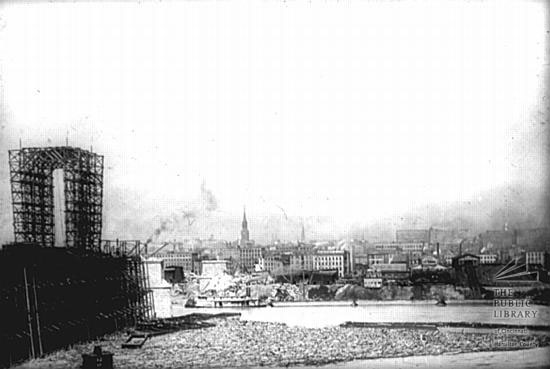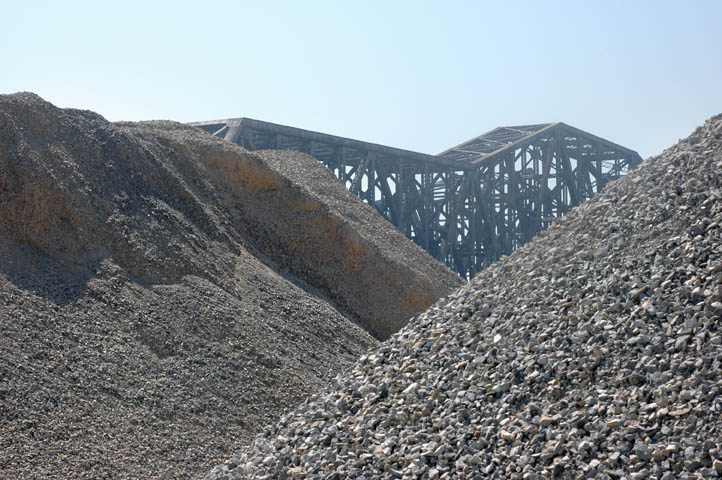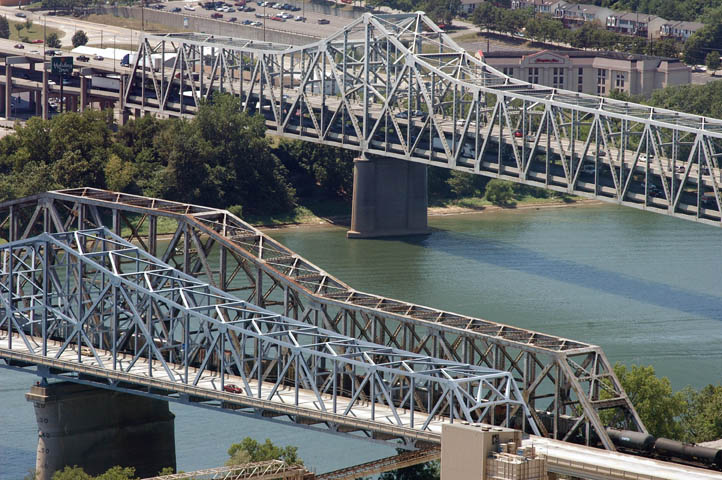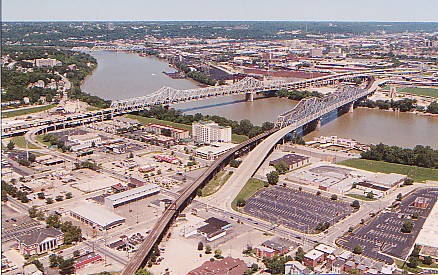
The original bridge under construction, circa 1887. PaulBrown Stadium now
stands in the right half of this photo.

The C&O Railroad terminated for decades at Huntington, West Virginia. Because the approach to Cincinnati along the Ohio River's north bank had been taken in the 1830's, the C&O was forced to build its line to Cincinnati along the river's southern shore and cross at Covington, KY. The bridge, designed by William Burr and constructed by the Philladelphia Bridge Company, was the city's first double-track bridge and at 545ft. had the longest center span of any railroad bridge in the world. Two aproach spans of 476ft. (both longer than the nearby L&N's center span), a cantilevered street car line, cart path, and two pedestrian walkways made the $5,000,000 bridge the most expensive, per foot, ever built.

The original bridge under construction, circa 1887. PaulBrown Stadium now
stands in the right half of this photo.
Bonds were issued by the "Covington and Cincinnati ElevatedRail and Transfer and Bridge Company" as construction began in 1886, witha completion set for 1888. A flood in August 1888 washed away the bridge'swooden falsework, taking some of the bridge with it, and delayed completionuntil 1889. When the C&O Bridge was completed it was hailed as an engineeringtriumph, but like the other railroad bridges it became obsolete as freightgrew ever heavier and by the 1920's required replacement. At the end ofits life the bridge carried nearly double the weight for which it was designed.

The original C&O Bridge, viewed from Covington.
Construction of today's double track bridge beganadjacent to the west side of the old bridge, with a longer 675ft. centralspan. The new C&O Bridge opened in 1929, with a continuous 850ft. trussthat is the second largest of its kind in the world. Whenthe replacement C&O Bridge opened, the original bridge was sold toKentucky and converted for automobile use. The southern pier of theoriginal bridge was extended for shared use by the new bridge, howeverthe same could obviously not be done for the northern pier, so for rivernavigation purposes the same 545ft. clearance persisted that had been inplace since 1889. The new C&O Bridge required a massive milelong viaduct to connect it with its yards and Union Terminal, which openedin 1933. The viaduct is still in use, and photos of it can be seenhere.A few of the original 1889 viaduct's piers were modified and reused onthe 1929 viaduct. A handful of others not reused were never dismantled,and can be seen today scattered around the area.

Today the C&O is extremely busy; often several trains cross per hour.
[August 1, 2005 Jake Mecklenborg]

The C&O is framed by its approach viaduct.
[August 1, 2005 Jake Mecklenborg]
The narrow shipping channel situation continued until1970, when the original C&O Bridge, facing major repairs, was blownup and construction of a new automobile bridge began in its place. Thenew bridge is a generic cantilever truss design, with a 675ft. main spanidentical to the adjacent 2nd C&O. The previously shared 1889/1929southern pier was reused and the 2nd C&O's northern pier was extendedwest, creating a 1929/1974 shared pier. The old C&O's northern mainspan pier was dismantled, allowing a clear 675ft. navigation channel beneath.

The Clay Wade Bailey, C&O, and Brent Spence Bridges viewed from the Carew Tower Observation Deck.
[August 1, 2005 Jake Mecklenborg]

C&O and Clay Wade Bailey Bridges viewed from Covington.The
Brent Spence Bridge is visible to the left. (Larry Stulz photo)